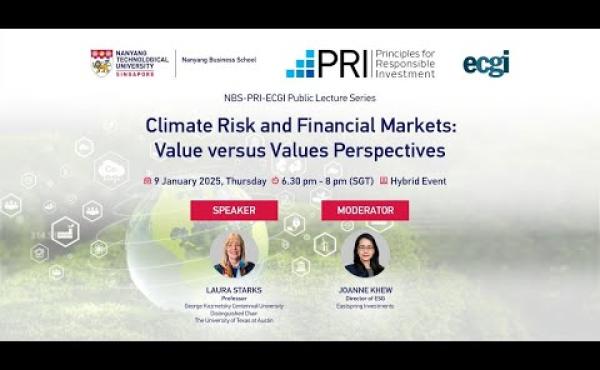
The ECGI blog is kindly supported by

Money and Morality in Climate Investing
A review of the lecture “Climate Risk and Financial Markets: Value versus Values Perspectives,” delivered by Professor Laura Starks.
On a humid evening in Singapore, under the sweeping arches of Nanyang Business School’s Gaia Auditorium, the stage was set for the inaugural session of the NBS-PRI-ECGI Public Lecture Series, with a compelling lecture on “Climate Risk and Financial Markets: Value versus Values Perspectives,” delivered by Professor Laura Starks from the University of Texas at Austin and ECGI. The hybrid event drew an impressive audience of over 1,121 registrants across 60 countries - a testament to the continued global significance of sustainable finance.
Professor Stark’s work has long shaped how investors and policymakers think about climate risk. Moving deftly between data and philosophy, economics and ethics - the new architecture of modern finance - Professor Starks’ lecture navigated the intricate interplay between “value” and “values” in climate finance. Drawing on extensive academic research, she delineated how financial and ethical considerations intersect in investment decisions.
The Value Perspective: Starks explained that climate risk is not only an ethical concern but a material financial issue. She shared evidence from bond and stock markets, showing how climate-related risks—from regulatory changes to physical impacts—are increasingly reflected in asset prices. For instance, she demonstrated how investors’ concerns about stranded assets and regulatory costs influence capital allocation. She also referenced a study examining the impact of the Paris Agreement on U.S. high-carbon-emitting firms' credit ratings. The findings showed a significant drop in these firms' credit ratings after the agreement, illustrating how regulatory changes influence financial metrics. She presented evidence on the performance of "green" versus "brown" firms, showing that firms with higher environmental ratings often outperform those with lower ratings, reflecting investor preference and regulatory impacts. She highlighted how climate policy uncertainty, such as changes in U.S. administrations, affects the valuation of carbon-intensive firms, and she noted that markets price in the risk of stricter future regulations, impacting stock prices and returns.
The Values Perspective: Starks emphasized that many investors are also motivated by ethical considerations. They seek to align their investments with their personal or organizational values, often prioritizing societal impact over financial returns. For instance, survey and experimental findings show that some retail investors are more sensitive to negative externalities, such as high carbon emissions, than to positive externalities. They often seek to divest from high-emission sectors to avoid contributing to climate change.
But these perspectives are not mutually exclusive. Starks’ survey findings highlighted that institutional investors, such as pension funds, are increasingly considering both fiduciary duty and ethical preferences in their investment strategies. Fiduciary duties may now include considering climate risk as a financial factor and many investors navigate a complex balancing act, seeking to achieve both financial returns and societal impact. The example of the Norwegian Sovereign Wealth Fund’s fossil fuel divestments illustrated this interplay effectively. She observed that institutional investors often prefer engagement over divestment, as it allows them to influence corporate behavior while maintaining their financial positions.
A Global Perspective
Starks’ lecture also illuminated regional disparities in ESG investing trends. Europe’s dominance in sustainable funds, both in volume and inflows, contrasted sharply with the U.S. and Asia’s more fragmented landscape. She attributed these differences to cultural norms, regulatory frameworks, and political dynamics. For instance, European countries’ stringent environmental regulations and societal emphasis on sustainability have spurred higher ESG adoption rates compared to other regions.
This regional variability extends to the measurement and definition of “green” investments. Starks’ analysis revealed conflicting methodologies for categorizing green and brown firms—ranging from ESG ratings and revenues to emissions intensity and absolute emissions—underscoring the urgent need for standardization. She shared visual data from the Morningstar report on ESG fund flows, which highlighted Europe’s leadership, the U.S.’s varied trends, and Asia’s significant inflows into passive funds. Starks also emphasized the role of cultural norms and politics, citing examples such as the French legislation requiring institutional investors to disclose climate risks, which spurred greater corporate transparency.
During the moderated Q&A session, Dr. Joanne Khew, Director of ESG at Eastspring Investments, raised pertinent questions about definitions, data clarity, and regulatory balance. Two critical takeaways emerged:
- The Necessity for Clarity: Both Starks and Khew underscored the importance of precise definitions and the matching of corresponding metrics in ESG investing. Whether through carbon intensity, emissions reductions, or third-party assurance, clearer standards are essential to mitigate greenwashing and enhance comparability. Starks highlighted the importance of assurance in carbon accounting as a key differentiator in gauging corporate climate ambitions.
- Balancing Regulation: Audience questions spotlighted the tension between regulatory burden and effectiveness. Starks acknowledged the risks of overregulation but maintained that robust disclosure requirements—such as those legislated in France—can drive meaningful corporate change without stifling innovation.
As the evening drew to a close, Starks emphasized the need for continued dialogue and research to deepen the understanding of climate risk. She shared examples from her research, such as the impact of the Paris Agreement on U.S. high-carbon-emitting firms’ credit ratings, which illustrated the material effects of regulatory changes on financial markets.
The lecture outlined how sustainable corporate practices can drive financial returns by mitigating risks, such as regulatory uncertainty, and capitalizing on opportunities in transitioning economies. She emphasized that climate risks—whether regulatory, physical, or strategic—have become significant factors influencing asset valuations and investment strategies.
-----------------------------------
The event was organised by NBS in collaboration with the Principles for Responsible Investment (PRI) and the European Corporate Governance Institute (ECGI), marking the beginning of an ambitious monthly series aimed at bridging the gap between academic research and industry practice. By fostering interdisciplinary dialogue among academics, practitioners, and policymakers, the series seeks to address some of the most pressing sustainability challenges of our time.
The inaugural lecture set a high bar for the series, which promises to deliver cutting-edge insights on ESG performance, climate resilience, and emerging trends in sustainable finance. With upcoming lectures by distinguished academics such as Pedro Matos and Madison Condon, the NBS-PRI-ECGI Public Lecture Series is poised to become a cornerstone of the global conversation on sustainable business.
Professor Jun Yang, Dean of NBS and a key proponent of the initiative, emphasized the importance of collaboration in tackling sustainability challenges. In her opening remarks, she noted NBS’s commitment to embedding sustainability across disciplines, highlighting the institution’s innovative programs such as the Executive Master in Sustainability Management and the Carbon Academy. Against this backdrop, the lecture series was positioned as a critical platform for advancing understanding and action on sustainability issues.







